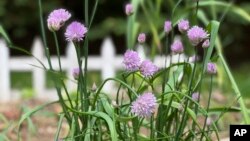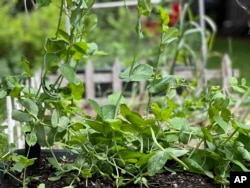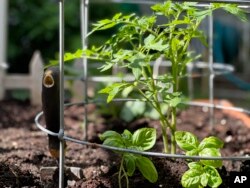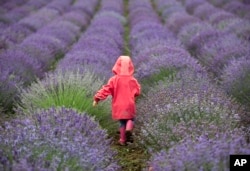From VOA Learning English, this is the Health & Lifestyle report.
People who grow fruit and vegetables in their gardens may worry about which plants to plant near each other. Some plants grow well together while others do not.
Studying which plants grow best together in nature can reduce the need for fertilizers and chemicals used to kill harmful insects and unwanted plants, or weeds.
Jessica Damiano is a gardening expert. She often writes about the subject for The Associated Press.
Damiano said Native Americans knew about companion planting hundreds of years ago. The Native American method of growing corn, beans, and squash together is a well-known example. They are called “the three sisters.”
Companion planting puts plants together that help each other grow – like, corn, beans, and squash do.
For those three, this is how it works. As the squash grows, its large, prickly leaves cover the ground. They block the sun to keep roots cool. They also keep out weeds and animals. Corn grows tall to support the vines of the beans. And the beans help bring nitrogen into the soil to fertilize all three plants.
Damiano added that other members of the bean family, such as peas and lentils, take nitrogen from the air. They then change it into a form that nourishes the soil and the plants growing in it.
At the end of a growing season, alfalfa or clover can be planted in cleared-out vegetable fields. This adds valuable nutrients to the soil. With those nutrients you may not need fertilizer during the next growing season.
Keeps bad insects and disease away
Some plants repel, or keep away, insects. Some plants also can protect against disease.
For example, basil repels these insects: mites, aphids, mosquitoes, and tomato hornworms. So, growing basil next to tomato plants is a good idea. Basil also has anti-fungal qualities.
Tomatoes, in turn, protect asparagus from beetles. Tomatoes also can protect roses from black spot, an often-deadly fungal disease.
French and African marigolds give off a chemical that repels many insects and kills some kinds of worms. Eelworms, for example, can damage the roots of vegetable and fruit crops.
Chrysanthemums produce natural chemicals that repel ticks, fleas, mosquitoes, flies, and other insects. The chemicals, known as pyrethrins, do their job so well that they have been copied to create manufactured insect repellents. Damiano asked: Why treat your plants with laboratory-made chemicals when they come from something naturally available and safe?
If your garden has slugs, Damiano suggests growing lavender.
Similarly, chives keep aphids from lettuce and roses. Sage repels cabbage moths. Oregano and radishes protect against squash beetles and cucumber beetles.
Damiano says, zinnias and parsnips draw ladybugs to your garden. Ladybugs eat many aphids and cabbage flies. Parsley and dill also draw ladybugs. But choose one or the other. They do not grow well together.
You also want to keep tomatoes away from potatoes, cabbage, and fennel. Tomatoes might make it hard for those plants to grow.
On the other hand, you do want to grow nasturtiums near tomatoes and squash. This edible flower improves the flavor of these vegetables growing nearby.
Be careful with sunflowers. They can stop the growth of beans and potatoes.
Also be careful with onions and garlic. They will hurt the growth of your asparagus, beans, leeks, and parsley. But, onions and garlic help beets, cabbage, carrots, lettuce, sage, strawberries, and tomatoes. Onion and garlic protect them against insects and diseases.
Cabbage and cauliflower are in the same vegetable family. But Damiano says not to plant them next to each other. Like family members who argue, they should be seated separately at the dinner table.
Damiano reminds us to plant friends with friends, and everyone will get along. Your garden will thank you.
And that’s the Health & Lifestyle report. I’m Anna Matteo.
Jessica Damiano wrote this story for The Associated Press. Anna Matteo adapted this story for VOA Learning English.
___________________________________________________________________
Words in This Story
garden –n. a piece of ground in which fruits, flowers, or vegetables are grown
companion planting –n. growing different kinds of plants (especially vegetables) close together in an effort to get results that help all of them, such as keeping insects away
prickly –adj. having many sharp points
vine –n. a plant with a very long stem that grows along the ground or climbs up other plants
anti-fungal –adj. having a quality that prevents fungus from growing
slug –n. a soft-bodied creature like a snail without a shell that is a kind of mollusk
edible –adj. able to be eaten
flavor –n. the quality of something that affects the sense of taste













